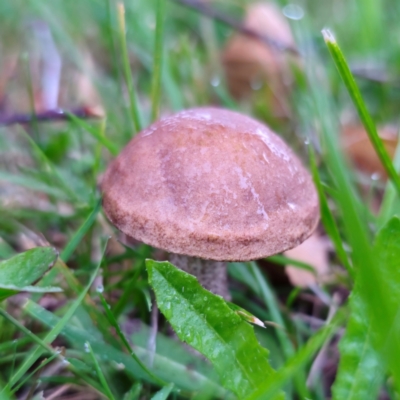Leccinum snelii (Snell's Bolete)
CAP: (3-9 cm) wide, rounded to convex, becoming broadly convex to nearly flat; surface dry, covered with tiny dark brown to black fibers when young, often fading to dark yellowish brown in age as the fibers erode, staining yellow in KOH; margin not rimmed with flaps of tissue, even when young; flesh white, staining pinkish to reddish, sometimes slowly, when cut and rubbed, especially at the juncture of the cap and stalk, not darkening to purple-gray or black, staining blue in FeSO4; odor and taste not distinctive.
PORE SURFACE: whitish when young, becoming grayish to dingy grayish brown in age, not blueing when cut or bruised but sometimes staining yellowish or brownish; pores circular, 2-3 per mm.
STALK: (4-11 cm) long, (1-2 cm) thick, nearly equal or enlarging slightly downward, solid, whitish beneath gray to black scabers, not reticulate, often with blue-green stains on the lower portion; stalk flesh typically staining blue-green, at least near the base, and often reddish above; partial veil and ring absent.
SPORE PRINT: brown.
MICROSCOPIC FEATURES: spores 16-22 x 5-7.5 μm, fusoid, smooth, pale brown.
FRUITING: scattered or in groups on the ground in mixed hardwoods, especially under yellow birch
EDIBILITY: edible.
Leccinum snelii is listed in the following regions:
Canberra & Southern Tablelands
Species information
- Leccinum snelii Scientific name
- Snell's Bolete Common name
- Unknown
- Unknown
- Unknown
- Machine learning
- External link More information






